Although all age groups are eligible to reap the benefits of participating in MMA, one question still remains: When is someone too young to go into the playing field?
While some schools don't mind a four-year-old training in their classes, other schools may not condone it. Training that starts at an early age focuses on simple movements and pushes them to learn more about their physical and mental capabilities.
Learning the Basics
If the school accepts them with open arms, they'll participate in low-risk training. At this age, children will be laying the foundation for a great future in the discipline of their choice. Four-year-olds that are told to wait can take karate to learn the basics. Karate will teach them the basis of respect, all while helping them progress. Studying MMA will also help younger children refine their motor skills and gain more control of their bodies.
Six to ten-year-olds are most likely to continue MMA into adulthood and earn a black belt if they continuously participate. Studies show that they'll also be a pro at martial arts training if they begin in this phase of life. By then, they'll have enough muscle control to punch and turn.
The eleven to twenty age group will only accept the art of MMA if their temperament level is aligned with what they're retaining. While some kids develop a degree of focus and skill earlier than others, starting in your adulthood is beneficial as well.
Improving MMA and Life Skills
The benefits parents see from their children after enrolling in MMA classes are improved focus, increased attention span, increased confidence, and better coordination.
Research shows that longer training is linked to lower aggressiveness in children. Secondly, this factor reduces bullying and helps students feel less stressed.
Martial arts helps students develop hand-to-hand combat to defend themselves. There are several forms of martial arts. The seven most popular ones are Karate, Kung Fu, Judo, Muay Thai, Brazilian Jiu Jitsu, Krav Maga, and Aikido.
Classes begin and end with a bow to the teacher. After warming up, students partake in the martial arts form of their choice. Sessions sometimes include kicks, punches, and blocks.
For kids to have the best experience in class, parents must look for classes that focus on character development and have free pre-evaluations so that the teacher can look at their strengths and challenges. It also helps the teacher and student to feel each other out. But, most importantly, parents should seek schools that are supportive and focused on their betterment.
Schedule Your Class Today!

